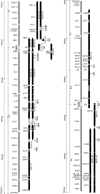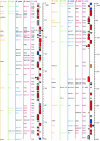Sequence finishing and gene mapping for Candida albicans chromosome 7 and syntenic analysis against the Saccharomyces cerevisiae genome
- PMID: 15937140
- PMCID: PMC1449773
- DOI: 10.1534/genetics.104.034652
Sequence finishing and gene mapping for Candida albicans chromosome 7 and syntenic analysis against the Saccharomyces cerevisiae genome
Abstract
The size of the genome in the opportunistic fungus Candida albicans is 15.6 Mb. Whole-genome shotgun sequencing was carried out at Stanford University where the sequences were assembled into 412 contigs. C. albicans is a diploid basically, and analysis of the sequence is complicated due to repeated sequences and to sequence polymorphism between homologous chromosomes. Chromosome 7 is 1 Mb in size and the best characterized of the 8 chromosomes in C. albicans. We assigned 16 of the contigs, ranging in length from 7309 to 267,590 bp, to chromosome 7 and determined sequences of 16 regions. These regions included four gaps, a misassembled sequence, and two major repeat sequences (MRS) of >16 kb. The length of the continuous sequence attained was 949,626 bp and provided complete coverage of chromosome 7 except for telomeric regions. Sequence analysis was carried out and predicted 404 genes, 11 of which included at least one intron. A 7-kb indel, which might be caused by a retrotransposon, was identified as the largest difference between the homologous chromosomes. Synteny analysis revealed that the degree of synteny between C. albicans and Saccharomyces cerevisiae is too weak to use for completion of the genomic sequence in C. albicans.
Figures









Similar articles
-
Assembly of the Candida albicans genome into sixteen supercontigs aligned on the eight chromosomes.Genome Biol. 2007;8(4):R52. doi: 10.1186/gb-2007-8-4-r52. Genome Biol. 2007. PMID: 17419877 Free PMC article.
-
Regions of microsynteny in Magnaporthe grisea and Neurospora crassa.Fungal Genet Biol. 2001 Jul;33(2):137-43. doi: 10.1006/fgbi.2001.1286. Fungal Genet Biol. 2001. PMID: 11456466
-
Single-read sequence tags of a limited number of genomic DNA fragments provide an inexpensive tool for comparative genome analysis.Yeast. 1998 Oct;14(14):1327-32. doi: 10.1002/(SICI)1097-0061(1998100)14:14<1327::AID-YEA321>3.0.CO;2-L. Yeast. 1998. PMID: 9802211
-
[Genomic analysis in Candida albicans].Nihon Ishinkin Gakkai Zasshi. 2003;44(2):81-5. doi: 10.3314/jjmm.44.81. Nihon Ishinkin Gakkai Zasshi. 2003. PMID: 12748588 Review. Japanese.
-
[Molecular biology of Candida albicans].Nihon Saikingaku Zasshi. 1995 Jul;50(3):671-85. doi: 10.3412/jsb.50.671. Nihon Saikingaku Zasshi. 1995. PMID: 7474341 Review. Japanese. No abstract available.
Cited by
-
An orthologous gene coevolution network provides insight into eukaryotic cellular and genomic structure and function.Sci Adv. 2022 May 6;8(18):eabn0105. doi: 10.1126/sciadv.abn0105. Epub 2022 May 4. Sci Adv. 2022. PMID: 35507651 Free PMC article.
-
Assembly of the Candida albicans genome into sixteen supercontigs aligned on the eight chromosomes.Genome Biol. 2007;8(4):R52. doi: 10.1186/gb-2007-8-4-r52. Genome Biol. 2007. PMID: 17419877 Free PMC article.
-
Candida and invasive candidiasis: back to basics.Eur J Clin Microbiol Infect Dis. 2012 Jan;31(1):21-31. doi: 10.1007/s10096-011-1273-3. Epub 2011 May 5. Eur J Clin Microbiol Infect Dis. 2012. PMID: 21544694 Review.
-
Sequence resources at the Candida Genome Database.Nucleic Acids Res. 2007 Jan;35(Database issue):D452-6. doi: 10.1093/nar/gkl899. Epub 2006 Nov 7. Nucleic Acids Res. 2007. PMID: 17090582 Free PMC article.
-
A novel mode of chromosomal evolution peculiar to filamentous Ascomycete fungi.Genome Biol. 2011;12(5):R45. doi: 10.1186/gb-2011-12-5-r45. Epub 2011 May 24. Genome Biol. 2011. PMID: 21605470 Free PMC article.
References
-
- Aggarwal, G., and R. Ramaswamy, 2002. Ab initio gene identification: prokaryote genome annotation with GeneScan and GLIMMER. J. Biosci. 27: 7–14. - PubMed
-
- Chibana, H., J. L. Beckerman and P. T. Magee, 2000. Fine-resolution physical mapping of genomic diversity in Candida albicans. Genome Res. 10: 1865–1877. - PubMed
-
- Chindamporn, A., Y. Nakagawa, I. Mizuguchi, H. Chibana, M. Doi et al., 1998. Repetitive sequences (RPSs) in the chromosomes of Candida albicans are sandwiched between two novel stretches, HOK and RB2, common to each chromosome. Microbiology 144(Pt. 4): 849–857. - PubMed
Publication types
MeSH terms
Substances
LinkOut - more resources
Full Text Sources
Other Literature Sources
Molecular Biology Databases
Research Materials
Miscellaneous

